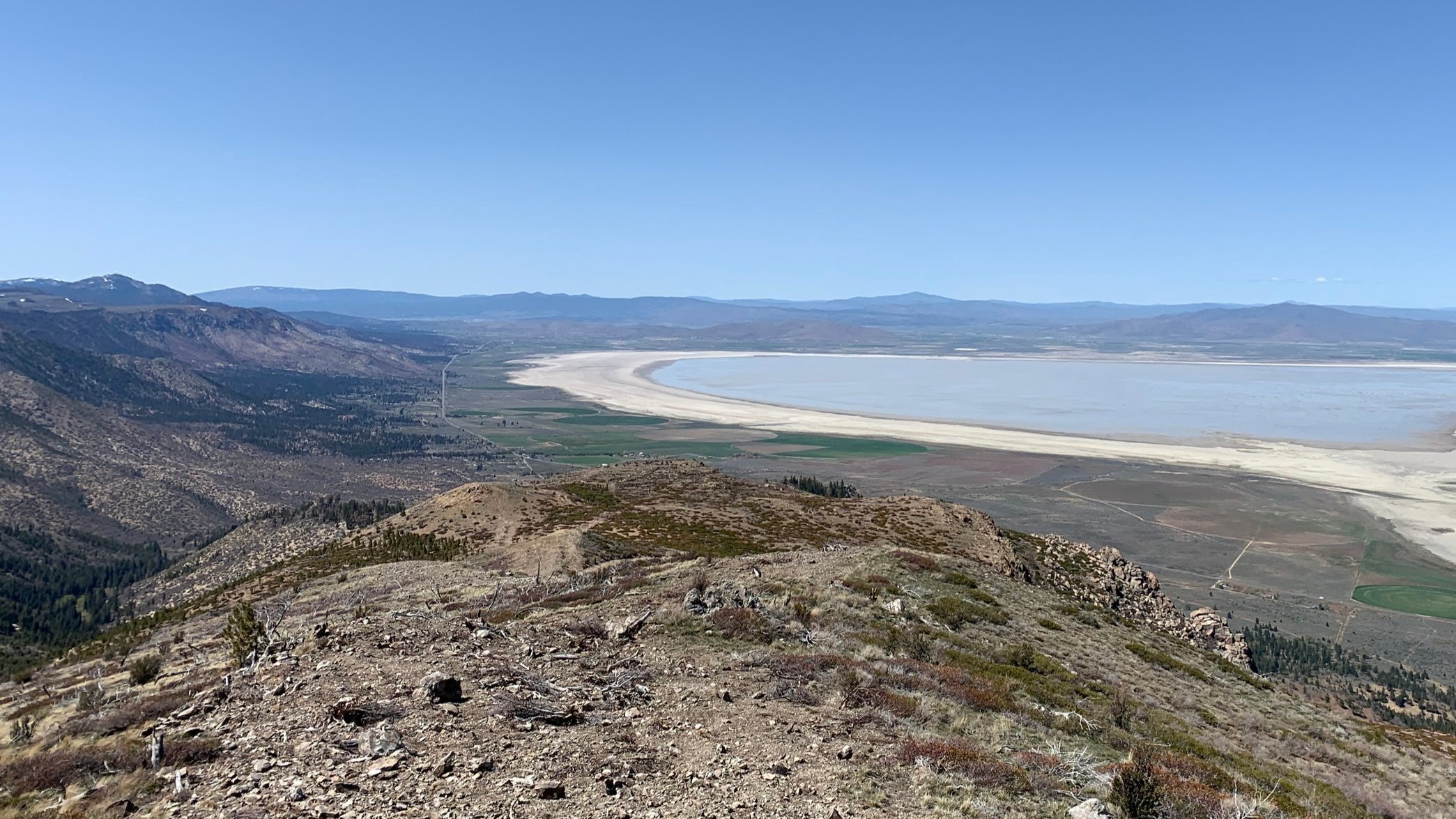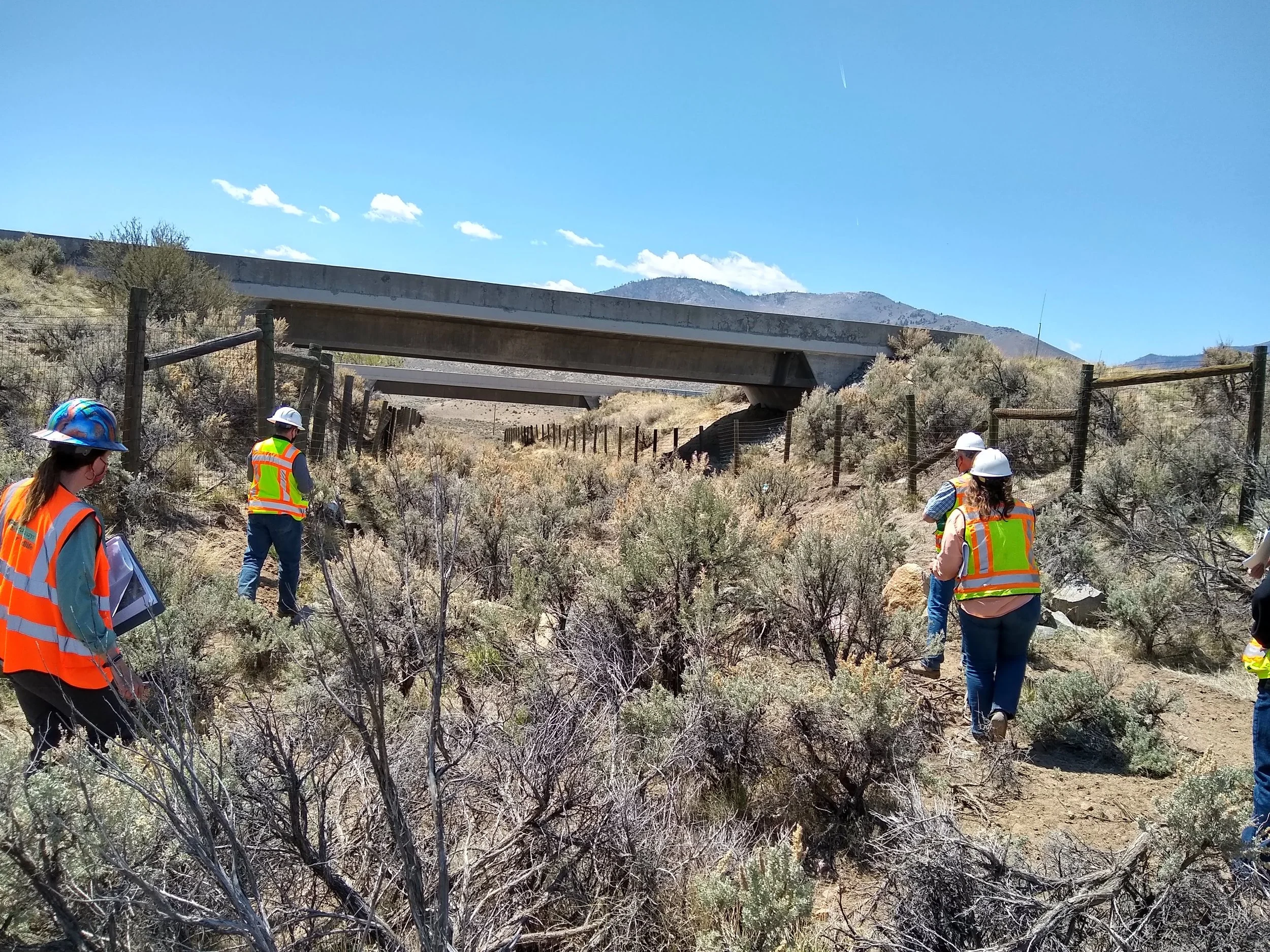Reconnecting Mountain Lions, Mule Deer, and More on Highway 395
A female mountain lion travels with her three cubs in a culvert under Highway 395 in Northern California. Photo: Pathways for Wildlife
A female mountain lion and her three cubs navigate a culvert beneath a bustling highway. This family traveling together means that this location is essential to their movement before the cubs disperse. Known for their expansive range from Canada to Chile, mountain lions need to secure resources and genetic diversity through vast territories that span from 25 to 700 square miles – almost 500,000 acres for one cat. Mountain lions need space, and the ability to access it.
Mule deer scamper through the same culvert. On the west side of this culvert is an ascent to mountains, cooler temperatures, and summer habitat for the deer. On the east side is low-lying sagebrush, offering optimal altitude, food, and water for winter habitat. Deer consistently move between the two for seasonal and daily movement, sometimes migrating more than 100 miles between ranges.
We call these mountains the Sierra Nevada and these plains of sagebrush the Modoc Plateau. Running along the base of the Sierra Nevada, atop the culvert, humans bifurcated this essential movement with a dangerous barrier – Highway 395.
A stretch of Highway 395 separating the Sierra Nevada range from lower-elevation plains.
"Like many highways in the West, U.S. 395 poses a barrier to the movement of all wildlife, great and small,” says Fraser Shilling, Director of Road Ecology at U.C. Davis. “In many stretches of U.S. 395 south of Susanville, we have found continuing high rates of collisions between wildlife and vehicles, posing a risk to the wildlife and the drivers."
Specifically, a 13-mile stretch of Highway 395 in Lassen County has no existing culverts or bridges wildlife can use. GPS collaring has identified this same stretch as a migration corridor for the Doyle deer herd, causing the Highway 395 project area to be one of the 10 worst deer-collision hotspots in the state.
Due to these death rates, habitat fragmentation, and persecution, mountain lions and mule deer – the two species most widely impacted by vehicle collisions in California – have been declining in numbers over the last few decades. Mountain lions only remain in 17 states, and deer populations have been steadily declining in Lassen County. When adult deer are killed by vehicles, they can’t teach their young where to migrate, potentially severing their migration corridors permanently.
To address the issue, conservation and restoration, local planning, and wildlife crossing infrastructure are essential to sustaining biodiversity and a future for these species. Wildlife crossings can improve wildlife movement while reducing dangerous wildlife-vehicle collisions by up to 100%.
Wildlands Network’s goal is to reconnect the landscapes between the Sierra Nevada range and the Modoc Plateau. Led by our California Program Director, Mari Galloway, we are working with our partners, the California Department of Transportation (Caltrans), the California Department of Fish and Wildlife, non-profits, Tribes, Lassen County, and others to share relevant information and data, secure necessary funding, coordinate needed land protections, and implement wildlife studies.
“We are devoted to one thing: wildlife movement. While others may focus on a particular place or topic, we specialize in the big picture, in landscape-scale connection, which is what wildlife need to survive. As a result, our team’s expertise runs the gamut, so we can deploy specialized strategies as needed for particular projects.”
We started by organizing. Though government agency staff had been working hard to move these connectivity efforts forward, a lack of organizational capacity inhibited action. In 2021, Wildlands Network stepped in to lead the charge, filling this gap by organizing diverse groups, hosting quarterly meetings for all stakeholders, and writing grants.
We then took to the field. In 2021, we hired Pathways for Wildlife to initiate camera studies, roadkill surveys, and animal-track monitoring across stretches of U.S. 395 in Lassen County. This research tells us which structures are accomplishing their goals, which are not, which species are moving (or attempting to move) across the highway, and where animals get hit most frequently. After analyzing this data, we discerned where wildlife would benefit most from highway crossings and what kinds of structures they need.
“The US-395 Wildlife Connectivity Study is important in that we are recording species such as mountain lion, bear, migratory deer, bobcat, coyote, badger, and gray fox using various culverts and bridges to travel under the highway,” notes Tanya Diamond, Co-Principal at Pathways for Wildlife. “Compared to the past thirteen years of connectivity studies we have been conducting, this is the first time that we have recorded all these species consistently traveling across a highway.”
This research forged significant progress: using our analysis, we worked with Lassen County and the U.C. Davis Road Ecology Center to apply for a multi-million-dollar Wildlife Conservation Board (WCB) grant for the planning and design of new wildlife crossings. Highway 395 is now on the agenda for WCB’s August hearing to be approved for funding!
If the grant is secured, our study data can inform plans and designs for constructing wildlife crossings throughout Highway 395 in Lassen County, and ultimately their construction in 2028. In addition to this grant, we are collaborating with partners to restore and conserve mule deer corridors and winter range through grants to fund post-fire remediation with Backcountry Hunters & Anglers, as well as collaboration over private land conservation in known migratory corridors for the sake of wildlife passage features.
“Our vast transportation network provides unique environmental challenges that require innovative solutions. Caltrans looks forward to working with colleagues on U.S. 395 to better understand these challenges and find responsible solutions that increase public safety, sustain wildlife habitats, and continue to deliver a safe and reliable transportation network for all.”
Wildlands Network visiting a Highway 395 underpass frequented by deer.
Beyond big infrastructure, little things go a long way to help wildlife. “I'm really excited that Caltrans will be using our research and partnership to conduct a safety project over the next few years that will update culverts, bridges, and fencing to improve the features that already exist and enhance safety for wildlife,” says Mari. “These data-based updates based on animal behavior are extremely important.”
Our vision is to reconnect habitat to facilitate critical wildlife movement in California and the entire Pacific Wildway. This progress in connectivity through wildlife crossings across Highway 395 will make significant change. We’re proud to protect the mountain lions, mule deer, and all other species that depend on movement to survive.



